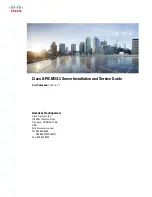
Chapter 13. Monitoring Server and Database Activity
374
3
— Write and execute
4
— Read only
5
— Read and execute
6
— Read and write
7
— Read, write, and execute
In the 3-digit number, the first digit represents the owner's permissions, the second digit represents
the group's permissions, and the third digit represents everyone's permissions. When changing
the default value, keep in mind that
000
will not allow access to the logs and that allowing write
permissions to everyone can result in the logs being overwritten or deleted by anyone.
The newly configured access mode will only affect new logs that are created; the mode will be set
when the log rotates to a new file.
•
The maximum number of logs for the directory to keep.
When the directory reaches this number of
logs, it deletes the oldest log file in the folder before creating a new log. The default is
10
logs. Do
not set this value to
1
, or the directory will not rotate the log, and the log will grow indefinitely.
•
The maximum size (in megabytes) for each log file.
To keep from setting a maximum size, type
-1
in this field. The default is
100
megabytes. Once a log file reaches this maximum size (or the
maximum age), the directory archives the file and starts a new one. Setting the maximum number of
logs to
1
causes the directory to ignore this attribute.
•
How often the directory archives the current log file and creates a new one
. The maximum age of
the file can be set in minutes, hours, days, weeks, or months. The logs can also be rotated at a
particular time of the day; for example, every day at midnight. The default is every day. Setting the
maximum number of logs to
1
causes the directory to ignore this attribute.
Each log file includes a title, which identifies the server version, hostname, and port, for ease of
archiving or exchanging log files. The title has the following form:
Red Hat-Directory/
version build_number hostname
:
port
(/usr/lib/dirsrv/slapd-
instance_name
)
For example, the first couple of lines of any log files generated by a Directory Server instance may
show lines similar to these:
Red Hat-Directory/8.0 B2007.188.1157 myhost.example.com:389 (/usr/lib/dirsrv/slapd-example)
13.1.2. Defining a Log File Deletion Policy
For the directory to automatically delete old archived logs, define a log file deletion policy from the
Directory Server Console.
NOTE
The log deletion policy only makes sense if there is already a defined log file rotation
policy. Log file deletion will not work if there is just one log file. The server evaluates the
log file deletion policy at the time of log rotation.
The log file deletion policy can be configured with the following parameters:
Summary of Contents for DIRECTORY SERVER 8.0
Page 18: ...xviii ...
Page 29: ...Configuring the Directory Manager 11 6 Enter the new password and confirm it 7 Click Save ...
Page 30: ...12 ...
Page 112: ...94 ...
Page 128: ...110 ...
Page 190: ...Chapter 6 Managing Access Control 172 4 Click New to open the Access Control Editor ...
Page 224: ...206 ...
Page 324: ...306 ...
Page 334: ...316 ...
Page 358: ...340 ...
Page 410: ...392 ...
Page 420: ...402 ...
Page 444: ...426 ...
Page 454: ...436 ...
Page 464: ...446 ...
Page 484: ...466 ...
Page 512: ...494 ...
Page 522: ...504 ...
















































